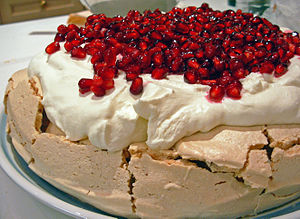Pavlova (dessert): Difference between revisions
m Reverted edits by 124.179.24.118 (talk) to last version by Kaiwhakahaere |
|||
| Line 7: | Line 7: | ||
==History== |
==History== |
||
Some sources say the recipe originated in [[New Zealand]], while others claim it was invented in [[Australia]]. However, like the [[Anzac biscuit]]<ref>http://www.ecook.co.nz/index.php/ps_pagename/featurearticles/pi_articleid/57 ANZAC biscuit origin reference</ref>, the earliest known books containing the recipe were published in [[ |
Some sources say the recipe originated in [[New Zealand]], while others claim it was invented in [[Australia]]. However, like the [[Anzac biscuit]]<ref>http://www.ecook.co.nz/index.php/ps_pagename/featurearticles/pi_articleid/57 ANZAC biscuit origin reference</ref>, the earliest known books containing the recipe were published in [[Australia]]. |
||
Professor Helen Leach, a culinary anthropologist at the [[University of Otago]] in New Zealand found a pavlova recipe in a 1933 [[Rangiora, New Zealand|Rangiora]] Mothers' Union cookery book.<ref name="gnt"/> Professor Leach also has an even earlier copy of the pavlova recipe from a 1929 rural New Zealand magazine,<ref name="gnt" /> ''New Zealand Dairy Annual (1929)''.<ref name="leach" /> |
Professor Helen Leach, a culinary anthropologist at the [[University of Otago]] in New Zealand found a pavlova recipe in a 1933 [[Rangiora, New Zealand|Rangiora]] Mothers' Union cookery book.<ref name="gnt"/> Professor Leach also has an even earlier copy of the pavlova recipe from a 1929 rural New Zealand magazine,<ref name="gnt" /> ''New Zealand Dairy Annual (1929)''.<ref name="leach" /> |
||
Revision as of 08:47, 22 January 2009

Pavlova is a meringue dessert named after the Russian ballet dancer Ánna Pávlova (Russian: А́нна Па́влова).[1] Unlike the dancer, whose name was Template:PronEng, the dessert's name is pronounced /pɑːvˈloʊvə, pæv-/, with the emphasis on the second syllable [2]. It is referred to colloquially as 'pav'. The dessert is crispy on the outside but light and fluffy inside. Historically, the name has been used to describe three distinct desserts; a four-layered jelly cake, [citation needed] a coffee flavoured meringue [citation needed] and the pavlova as understood today, the fluffy meringue dessert.[3]
The dessert is believed to have been created to honour the dancer during or after one of her tours to Australia and New Zealand. The exact location of its first creation and the nationality of its creator has been a source of argument between the two countries for many years, however more serious research into the matter indicates New Zealand as source of today's pavlova.[3]
The dessert is a popular dish and an important part of the national cuisine of both countries, and is frequently eaten during celebratory or holiday meals such as Christmas dinner.
History
Some sources say the recipe originated in New Zealand, while others claim it was invented in Australia. However, like the Anzac biscuit[4], the earliest known books containing the recipe were published in Australia.
Professor Helen Leach, a culinary anthropologist at the University of Otago in New Zealand found a pavlova recipe in a 1933 Rangiora Mothers' Union cookery book.[1] Professor Leach also has an even earlier copy of the pavlova recipe from a 1929 rural New Zealand magazine,[1] New Zealand Dairy Annual (1929).[3]
Keith Money, a biographer of Anna Pavlova, wrote that a New Zealand chef in a hotel in Wellington, New Zealand, created the dish when Pavlova visited there in 1926 on her world tour. [5]
The claim that it was an Australian invention states that the pavlova is based on a cake baked by Bert Sachse at the Esplanade Hotel in Perth on October 3, 1935,[citation needed] significantly later than the New Zealand claim.
Preparation and consumption
Pavlova is made by beating egg whites (and sometimes salt) to a very stiff consistency before folding in caster sugar, white vinegar, cornstarch plus vanilla sometimes, and slow-baking the mixture to create the meringue.[6] This makes the outside of the pavlova a crisp crunchy shell, while the interior remains soft and moist. The pavlova's internal consistency is thus completely different from that normally associated with meringue, having more of a soft marshmallow texture.

Pavlova is traditionally decorated with topping of whipped cream and fresh fruit of sweet/tart flavours, such as strawberries and kiwifruit, or passionfruit and banana or berries and peach slices.[7] Raspberry is a popular topping in the United Kingdom, with the tartness of raspberries contrasting with the sweetness of sugar. Factory-made pavlovas can be purchased at supermarkets and decorated as desired. A commercial product is available that includes pre-mixed ingredients for baking the meringue shell, requiring only the addition of water and sugar.
Leftover decorated pavlova can be refrigerated overnight, but the dessert will absorb moisture from the air and lose its crispness. Undecorated pavlova can safely be left overnight in the oven in which it was baked, to be decorated in the morning.
New Zealand advertising campaign
In 2007, insurance company NZI ran a humorous television advertisement [8] highlighting historic New Zealand icons adopted elsewhere, including the pavlova and Phar Lap by Australia. NZI's parent company is Australian owned.
World's largest pavlova
Te Papa, New Zealand's national museum in Wellington, celebrated its first birthday in February 1999 with the creation of the world's largest pavlova, named "Pavzilla", cut by the Prime Minister of New Zealand of the time, Jenny Shipley.
Further reading
- Leach, Helen M. (1997). The pavlova cake: the evolution of a national dish. In Harlan Walker (ed.), Food on the Move: Proceedings of the Oxford Symposium on Food and Cookery, 1996 (pp. 219-223). Devon, England: Prospect Books. ISBN 0-907325-79-3.
References
- ^ a b c Boylen, Jeremy (reporter) (2004, August 20).Pavlova George Negus Tonight, Australian Broadcasting Corporation.
- ^ Orsman, H.W. (ed.) (1979) Heinemann New Zealand dictionary. Auckland: Heinemann Educational Books (N.Z.)
- ^ a b c Leach, Helen, The Pavlova Story, 2008
- ^ http://www.ecook.co.nz/index.php/ps_pagename/featurearticles/pi_articleid/57 ANZAC biscuit origin reference
- ^ Pavlova, History of Pavlova
- ^ http://www.elise.com/recipes/archives/004356pavlova.php Pavlova Recipe
- ^ http://www.inmamaskitchen.com/FOOD_IS_ART/pavlova_howto.html Contains Pavlova Toppings
- ^ YouTube - Someone always wants to steal your stuff!!!